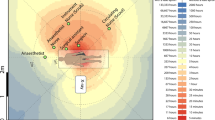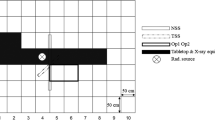Abstract
The use of hand-held dental X-ray units is increasing within Australia since their portability is advantageous in applications such as aged care. However, proximity of the operator to the X-ray unit raises radiation safety concerns. The aim of this study was to evaluate operator radiation exposure and methods of dose reduction for the Rextar X camera-style hand-held dental X-ray unit. Leakage and scattered radiation were measured using a solid state detector. Scatter was generated using a Perspex head phantom. Measurements of scattered radiation dose as a function of distance were made with and without a lead acrylic scatter shield (0.6 mm Pb equivalence at 100 kVp) attached to the X-ray unit. Without the scatter shield, doses to the operator from a single adult maxillary molar X-ray exposure were 0.69, 0.78 and 0.47 µGy at the left hand, right hand and eyes respectively. With the scatter shield attached, doses were reduced to 0.25, 0.12 and 0.15 µGy respectively, corresponding to a dose reduction of 64, 85 and 68%. The contribution from leakage radiation was insignificant in comparison. It is highly unlikely that an operator would reach occupational dose limits when using the Rextar X hand-held dental X-ray unit, even without the scatter shield in place. Nevertheless, it is strongly recommended that the scatter shield is attached to keep operator doses as low as reasonably achievable. Use of the scatter shield additionally ensures compliance with the Australian legislative requirement for a protective barrier and is considered a preferable alternative to X-ray protective clothing.






Similar content being viewed by others
References
Gray J, Bailey E, Ludlow J (2012) Dental staff doses with handheld dental intraoral X-ray units. Health Phys 102(2):137–142
Danforth RA, Herschaft EE, Leonowich JA (2009) Operator exposure to scatter radiation from a portable hand-held dental radiation emitting device (AribexTM NOMADTM) while making 915 intraoral dental radiographs. J Forensic Sci 54(2):415–421
Pittayapat P, Oliveira-Santos C, Thevissen P, Michielsen K, Bergans N, Willems G, Debruyckere D, Jacobs R (2010) Image quality assessment and medical physics evaluation of different portable dental X-ray units. Forensic Sci Int 201:112–117
Hermsen KP, Jaeger SS, Jaeger MA (2008) Radiation safety for the NOMADTM portable X-ray system in a temporary morgue setting. J Forensic Sci 53(4):917–921
Cho J, Han W (2012) The reduction methods of operator’s radiation dose for portable dental X-ray machines. Restor Dent Endod 37(3):160–164
Coy J, Vandre RH, Davidson WR (1997) Use of the hand-held dental X-ray machine during joint operation, NATO exercise Display Determination-92. Mil Med 162(8):575–577
NSW Health Primary Schools Dental Program. https://www.health.nsw.gov.au/oralhealth/primaryschooldental/Pages/default.aspx. Accessed 28 Jul 2020
Gulson AD, Holroyd JR (2016) Guidance on the Safe Use of Hand-Held Dental X-ray Equipment. Public Health England. https://www.gov.uk/government/publications/hand-held-dental-x-ray-equipment-guidance-on-safe-use. Accessed 18 May 2020
Berkhout WER, Suomalainen A, Brüllmann D, Jacobs R, Horner K, Stamatakis HC (2015) Justification and good practice in using handheld portable dental X-ray equipment: a position paper prepared by the European Academy of DentoMaxilloFacial Radiology (EADMFR). Dentomaxillofac Radiol 44(6):20140343
QA Collectible: Hand-Held Dental X-ray Units (2010) CRCPD Committee on quality assurance in diagnostic X-ray (H-7). Conference of Radiation Control Program Directors, Inc.
Suggested State Regulations for Control of Radiation SSRCR (2015) Part F: medical diagnostic and interventional X-ray and imaging systems. Conference of Radiation Control Program Directors, Inc., vol 1
Australian/New Zealand StandardTM AS/NZS 3200.2.201:2000 (2000) Medical electrical equipment. Part 2.201: particular requirements for safety—dento-maxillofacial X-ray equipment
NSW Environment Protection Authority (EPA) (2004) Radiation Guideline 6. Registration requirements and industry best practice for ionising radiation apparatus used in diagnostic imaging. Part 3: dentistry (including maxillofacial). 2nd edn
Australian Radiation Protection and Nuclear Safety Agency (ARPANSA) (2005) Code of practice and safety guide. Radiation Protection Series No. 10. Radiation Protection in Dentistry
The Ionising Radiations Regulations (1999) UK Statutory Instruments 1999 No. 3232. http://www.legislation.gov.uk/uksi/1999/3232/contents/made. Accessed 8 Oct 2020
Goren AD, Bonvento M, Biernacki J, Colosi DC (2008) Radiation exposure with the NOMADTM portable X-ray system. Dentomaxillofac Radiol 37:109–112
McGiff TJ, Danforth RA, Herschaft EE (2012) Maintaining radiation exposures as low as reasonably achievable (ALARA) for dental personnel operating portable hand-held X-ray equipment. Health Phys 103(Supplement 2):S179–S185
Medicines and Healthcare products Regulatory Agency (MHRA) (2012) Medical Device Alert: non CE-marked portable dental X-ray units including the Tianjie Dental ‘Falcon’ (MDA/2012/046). https://assets.publishing.service.gov.uk/media/5485abeaed915d4c1000026b/con173763.pdf. Accessed 8 Oct 2020
Roberts M (2012). Dental X-ray machine radiation danger alert. BBC News. https://www.bbc.com/news/health-20579318 Accessed 8 Oct 2020
NSW Environment Protection Authority (EPA) (2004) Radiation Guideline 6. Registration requirements and industry best practice for ionising radiation apparatus used in diagnostic imaging. Part 6: test protocols for parts 2–5, 2nd edn
Australian/New Zealand StandardTM AS/NZS 4543.1:1999 (1999) Protective devices against diagnostic medical X-radiation. Part 1: determination of attenuation properties of materials
Radiation Control Regulation (2013) NSW legislation. https://www.legislation.nsw.gov.au/. Accessed 8 Oct 2020
Australian Radiation Protection and Nuclear Safety Agency (ARPANSA) (2020) Radiation Protection Series C-1 (Rev. 1)—code for radiation protection in planned exposure situations
International Commission on Radiological Protection (ICRP) (2007) The 2007 Recommendations of the International Commission on Radiological Protection, ICRP Publication 103
National Council on Radiation Protection and Measurements (2010) Report on radiation protection in dentistry. NCRP, Bethesda
US Department of Health and Human Services, Food and Drug Administration, Center for Devices and Radiological Health (2008) Guidance for industry and FDA staff: radiation safety considerations for X-ray equipment designed for hand-held use. https://www.fda.gov/media/73890/download Accessed 8 Oct 2020
Kim E (2012) Effect of the amount of battery charge on tube voltage in different hand-held dental x-ray systems. Imaging Sci Dent 42(1):1–4
Acknowledgements
The authors would like to acknowledge Karen Sleishman, Jared Walters and the team at Hunter New England Oral Health, Newcastle for the loan of the Rextar X unit and providing valuable advice on clinical applications and practical use. We also wish to acknowledge Thomas Greig for his advice on study design and methodology.
Author information
Authors and Affiliations
Corresponding author
Ethics declarations
Funding
No funding was received for conducting this study.
Conflicts of interest/competing interests
The authors have no relevant financial or non-financial interests to disclose.
Ethics approval
This research did not involve human participants, animals, their data or biological material. Therefore ethics approval was not required.
Consent
Not applicable.
Additional information
Publisher's Note
Springer Nature remains neutral with regard to jurisdictional claims in published maps and institutional affiliations.
Rights and permissions
About this article
Cite this article
Leadbeatter, J., Diffey, J. Evaluation of radiation exposure to operators of portable hand-held dental X-ray units. Phys Eng Sci Med 44, 377–385 (2021). https://doi.org/10.1007/s13246-021-00985-5
Received:
Accepted:
Published:
Issue Date:
DOI: https://doi.org/10.1007/s13246-021-00985-5




